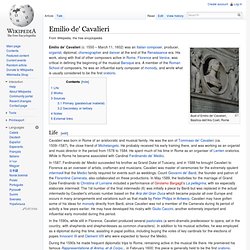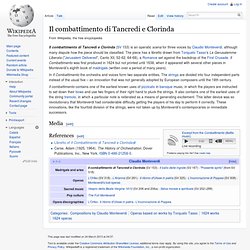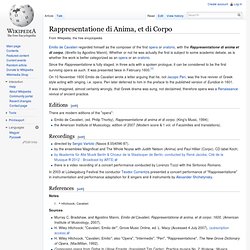

Emilio de' Cavalieri. Bust of Emilio de' Cavalieri, Basilica dell'Ara Coeli, Rome Emilio de' Cavalieri (c. 1550 – March 11, 1602) was an Italian composer, producer, organist, diplomat, choreographer and dancer at the end of the Renaissance era.

His work, along with that of other composers active in Rome, Florence and Venice, was critical in defining the beginning of the musical Baroque era. A member of the Roman School of composers, he was an influential early composer of monody, and wrote what is usually considered to be the first oratorio. Life[edit] Cavalieri was born in Rome of an aristocratic and musical family. In 1587, Ferdinando de' Medici succeeded his brother as Grand Duke of Tuscany, and in 1588 he brought Cavalieri to Florence as an overseer of artists, craftsmen and musicians. In the 1590s, while still in Florence, Cavalieri produced several pastorales (a semi-dramatic predecessor to opera, set in the country, with shepherds and shepherdesses as common characters). Works[edit] Il combattimento di Tancredi e Clorinda. In Il Combattimento the orchestra and voices form two separate entities.

The strings are divided into four independent parts instead of the usual five – an innovation that was not generally adopted by European composers until the 18th century. Claudio Monteverdi. Claudio Giovanni Antonio Monteverdi (Italian: [ˈklaudjo monteˈverdi]; 15 May 1567 (baptized) – 29 November 1643) was an Italian composer, gambist, singer and Roman Catholic priest.

Monteverdi's work, often regarded as revolutionary, marked the change from the Renaissance style of music to that of the Baroque period.[2] He developed two styles of composition – the heritage of Renaissance polyphony and the new basso continuo technique of the Baroque.[3] Monteverdi wrote one of the earliest operas, L'Orfeo, a novel work that is the earliest surviving opera still regularly performed. He is widely recognized as an inventive composer who enjoyed considerable fame in his life-time. Life[edit] Claudio Monteverdi has been proposed as the subject of this Portrait of a Musician by a Cremonese artist (c. 1570–1590, now at the Ashmolean Museum, Oxford).[4] If correct, it would be his earliest known portrait, possibly painted when he was at the Gonzaga Court in Mantua. Works[edit] Madrigals[edit] Notes. Rappresentatione di Anima, et di Corpo. Emilio de Cavalieri regarded himself as the composer of the first opera or oratorio, with the Rappresentatione di anima et di corpo, (libretto by Agostino Manni).

Whether or not he was actually the first is subject to some academic debate, as is whether the work is better categorized as an opera or an oratorio. Since the Rappresentatione is fully staged, in three acts with a spoken prologue, it can be considered to be the first surviving opera as such. It was presented twice in February 1600.[1] On 10 November 1600 Emilio de Cavalieri wrote a letter arguing that he, not Jacopo Peri, was the true reviver of Greek style acting with singing, i.e. opera. Peri later deferred to him in the preface to the published version of Euridice in 1601. It was imagined, almost certainly wrongly, that Greek drama was sung, not declaimed, therefore opera was a Renaissance revival of ancient practice. Editions[edit] There are modern editions of the "opera":
Oratorio. History[edit] 1600, origins of the oratorio[edit] Although medieval plays such as the Ludus Danielis, and Renaissance dialogue motets such as those of the Oltremontani had characteristics of an oratorio, the first oratorio is usually seen as Emilio de Cavalieri's Rappresentatione di Anima, et di Corpo.

Monteverdi composed Il Combattimento di Tancredi e Clorinda which can be considered as the first secular oratorio. 1650–1700[edit] By the mid-17th century, two types had developed: Lasting about 30–60 minutes, oratorio volgares were performed in two sections, separated by a sermon; their music resembles that of contemporary operas and chamber cantatas. oratorio latino (in Latin) – first developed at the Oratorio del Santissimo Crocifisso, related to the church of San Marcello al Corso in Rome.